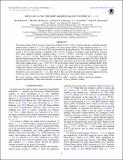| dc.contributor.author | Brodwin, Mark | |
| dc.contributor.author | Gonzalez, Anthony H. | |
| dc.contributor.author | Stanford, S. A. | |
| dc.contributor.author | Eisenhardt, Peter R. | |
| dc.contributor.author | Stern, Daniel | |
| dc.contributor.author | Zeimann, Gregory R. | |
| dc.contributor.author | McDonald, Michael A. | |
| dc.date.accessioned | 2016-05-23T23:56:01Z | |
| dc.date.available | 2016-05-23T23:56:01Z | |
| dc.date.issued | 2016-01 | |
| dc.date.submitted | 2015-04 | |
| dc.identifier.issn | 1538-4357 | |
| dc.identifier.issn | 0004-637X | |
| dc.identifier.uri | http://hdl.handle.net/1721.1/102642 | |
| dc.description.abstract | We present a deep (100 ks) Chandra observation of IDCS J1426.5+3508, a spectroscopically confirmed, infrared-selected galaxy cluster at z = 1.75. This cluster is the most massive galaxy cluster currently known at z > 1.5, based on existing Sunyaev–Zel'dovich (SZ) and gravitational lensing detections. We confirm this high mass via a variety of X-ray scaling relations, including T[subscript X]–M, f[subscript g]–M, Y[subscript X]–M, and L[subscript X]–M, finding a tight distribution of masses from these different methods, spanning M[subscript 500] = 2.3–3.3 × 10[superscript 14]M[subscript ⊙], with the low-scatter Y[subscript X]-based mass M[subscript 500,Y[subscript X]] = 2.6[+1.5 over -0.5] x 10[superscript 14] M[subscript ⊙]. IDCS J1426.5+3508 is currently the only cluster at z > 1.5 for which X-ray, SZ, and gravitational lensing mass estimates exist, and these are in remarkably good agreement. We find a relatively tight distribution of the gas-to-total mass ratio, employing total masses from all of the aforementioned indicators, with values ranging from f[subscript gas,500] = 0.087–0.12. We do not detect metals in the intracluster medium (ICM) of this system, placing a 2σ upper limit of Z(r < R[subscript 500]) < 0.18 Z[subscript ⊙]. This upper limit on the metallicity suggests that this system may still be in the process of enriching its ICM. The cluster has a dense, low-entropy core, offset by ~30 kpc from the X-ray centroid, which makes it one of the few "cool core" clusters discovered at z > 1, and the first known cool core cluster at z > 1.2. The offset of this core from the large-scale centroid suggests that this cluster has had a relatively recent ([< over ~]500 Myr) merger/interaction with another massive system. | en_US |
| dc.language.iso | en_US | |
| dc.publisher | IOP Publishing | en_US |
| dc.relation.isversionof | http://dx.doi.org/10.3847/0004-637x/817/2/122 | en_US |
| dc.rights | Article is made available in accordance with the publisher's policy and may be subject to US copyright law. Please refer to the publisher's site for terms of use. | en_US |
| dc.source | IOP Publishing | en_US |
| dc.title | IDCS J1426.5+3508: THE MOST MASSIVE GALAXY CLUSTER AT z > 1.5 | en_US |
| dc.type | Article | en_US |
| dc.identifier.citation | Brodwin, Mark, Michael McDonald, Anthony H. Gonzalez, S. A. Stanford, Peter R. Eisenhardt, Daniel Stern, and Gregory R. Zeimann. “ IDCS J1426.5+3508: THE MOST MASSIVE GALAXY CLUSTER AT z > 1.5 .” The Astrophysical Journal 817, no. 2 (January 27, 2016): 122. © 2016 The American Astronomical Society | en_US |
| dc.contributor.department | Massachusetts Institute of Technology. Department of Physics | en_US |
| dc.contributor.department | MIT Kavli Institute for Astrophysics and Space Research | en_US |
| dc.contributor.mitauthor | McDonald, Michael A. | en_US |
| dc.relation.journal | The Astrophysical Journal | en_US |
| dc.eprint.version | Final published version | en_US |
| dc.type.uri | http://purl.org/eprint/type/JournalArticle | en_US |
| eprint.status | http://purl.org/eprint/status/PeerReviewed | en_US |
| dspace.orderedauthors | Brodwin, Mark; McDonald, Michael; Gonzalez, Anthony H.; Stanford, S. A.; Eisenhardt, Peter R.; Stern, Daniel; Zeimann, Gregory R. | en_US |
| dspace.embargo.terms | N | en_US |
| mit.license | PUBLISHER_POLICY | en_US |
